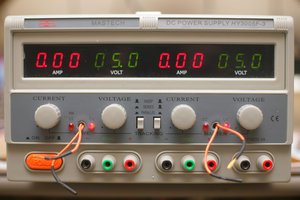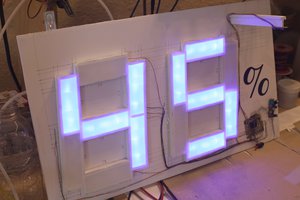The things which got most of us interested in electronics were blinking lights, buzzers, & motors. For lions, it was actually incandescent lights because 40 years ago, incandescent lights were bright while LEDs were disappointingly dim. Heating a filament with a battery was also a lot more intuitive than electrons jumping into holes. Eventually, the practicality of those dim LEDs took over.
There won't be a museum piece with incandescent light because it would be too expensive to power. Blinking LEDs were eventually the only reason lions cared about electronics as cubs. 1 day in 1984 stood out as the day when 2 LEDs just happened to blink. Then the lion kingdom tore down the circuit.
It remaned a warm memory in later years as the lion kingdom spent a lot of time hacking together circuits, trying to recreate the same blinking, to no avail. After burning out all the LEDs & giving up, the kits were relegated to just a crystal radio.
The internet finally solved the problem & the lion kingdom made a multivibrator 15 years ago to close the circle. There's magic in seeing a small number of discrete components blinking LEDs which a computer applying thousands of transistors to the same task can't convey. It was tempting to build a permanent one by point to point soldering all the leads, emphasizing that it is indeed discrete components & stick it on a wall for display.
As a bonus, the display got a buzzer based on the same circuit.
The entire display takes 0.13A at 5V for just the LED blinker. Running the buzzer brings it to 40mA. The decision was made to use only spare parts that existed 40 years ago. It has original LEDs made in 1979, only 3904 transistors, & a switch from 1979. The electrolytic capacitors would have also existed.
Helas, the polymer film capacitors on the buzzer side did not exist in consumer products, 40 years ago. All we had were ceramic disc capacitors, which have all disintegrated. Kapton tape wasn't used in consumer products either, but the lion kingdom needed something durable & transparent. Scotch tape wasn't transparent or as durable as it is now, but good luck finding vintage scotch tape anywhere. The speaker is much smaller than what we had 40 years ago, but there wasn't enough room for a bigger speaker.
The LEDs are incredibly dim. They agree with memories of how incredibly dim LEDs were. You can't appreciate the world we lived in 40 years ago without seeing them in real life. They were only diffuse & 4mm, never clear or surface mount. Years of burning out this stock of 1979 LEDs convinced the lion kingdom that this was truly as bright as they were. They run at around 1.7V & rapidly burn out above that. Indoor lighting is a lot brighter than it was, making them appear dimmer.
The buzzer is very faint, but this too agrees with what a lion would have heard 40 years ago. The room was dark & quiet, making the buzzer sound a lot louder. We didn't have as many things capable of making noise.
https://www.youtube.com/watch?v=jD5wwg_gaL4
One trick was getting the blinking rate slow enough so it would look obviously like capacitors charging to create the delay.
 lion mclionhead
lion mclionhead



 Ajaysunny
Ajaysunny